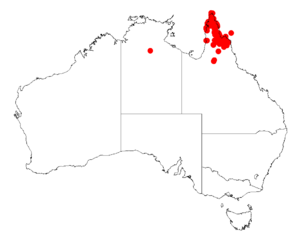Tooroo facts for kids
Quick facts for kids Tooroo |
|
|---|---|
| Scientific classification | |
| Genus: |
Acacia
|
| Species: |
rothii
|
 |
|
| Where Tooroo trees grow in Australia | |
The Acacia rothii, also known as tooroo, Roth's wattle, lancewood, or spoon tree, is a type of shrub or small tree. It belongs to the Acacia family, which is a large group of plants. This particular tree is special because it is found only in a specific area of north-eastern Australia. This means it is endemic to that region.
What Tooroo Looks Like
This tree usually grows to be about 6 to 12 meters (around 20 to 40 feet) tall. It has branches that spread out, forming an open shape, and its trunk is usually quite straight. The bark is rough and dark grey-brown. Its younger branches are smooth and have sharp edges.
Like many Acacia species, the Tooroo tree doesn't have typical leaves. Instead, it has what are called phyllodes. These are flattened leaf stems that look and act like leaves. The phyllodes of the Tooroo are smooth and stay green all year round. They are shaped like a narrow oval or a gentle sickle, measuring about 15 to 30 centimeters (6 to 12 inches) long and 1.5 to 3.5 centimeters (0.6 to 1.4 inches) wide. Each phyllode has two or three clear lines running along its length.
How Tooroo Got Its Name
The Tooroo tree was first officially described by a botanist named Frederick Manson Bailey in the year 1900. He wrote about it in a publication called Contributions to the Flora of Queensland.
Later, in 1987, another botanist named Leslie Pedley changed its scientific name to Racosperma rothii. However, in 2001, it was moved back to the Acacia group. The Tooroo tree is quite similar to another Acacia species called Acacia mimula and is also thought to be related to Acacia bakeri.
Where Tooroo Grows
You can mostly find the Tooroo tree in far north Queensland, Australia. It likes to grow on flat or gently rolling plains and low hills. These areas can be as high as 800 meters (about 2,600 feet) above sea level.
The Tooroo tree usually grows in sandy or loamy soils that are reddish and rich in iron, often called lateritic soils. It is commonly found as part of Eucalyptus woodland areas. The places where this tree grows stretch from the very northern tip of the Cape York Peninsula all the way down to the Palmer River in the south.

